discomfort support

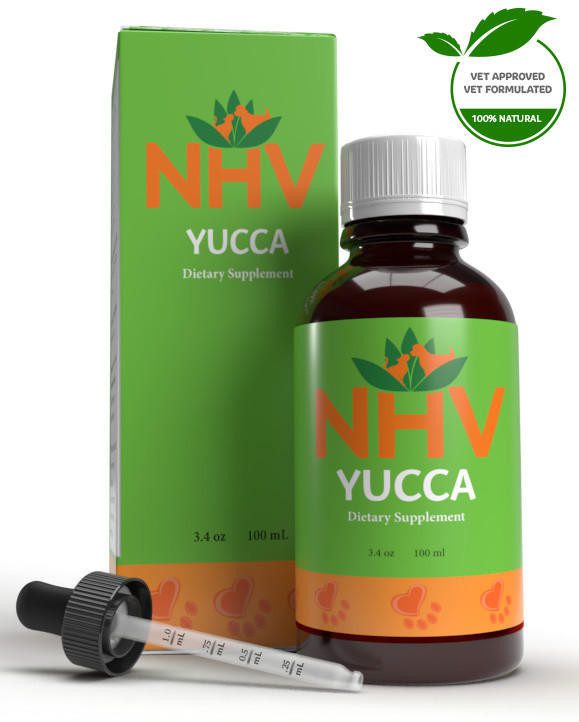
free shipping over $100 (USA & Canada)
1-877-937-4372 the pet expert hotline
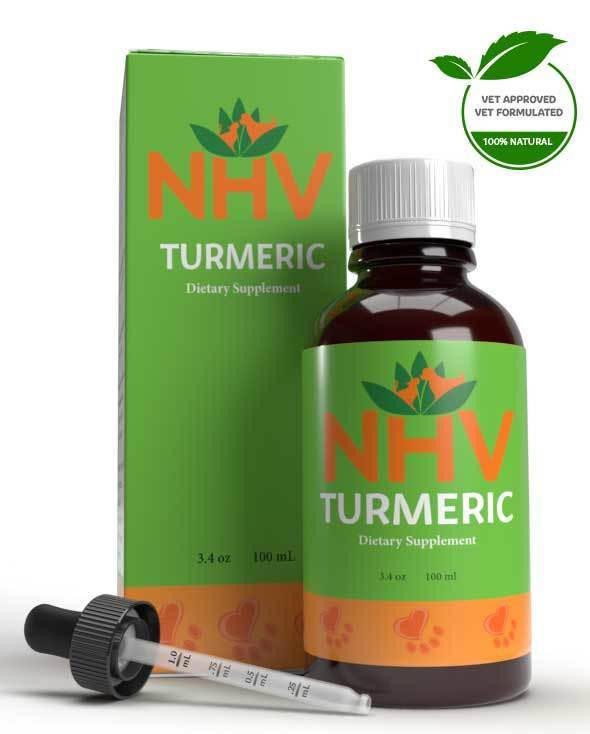
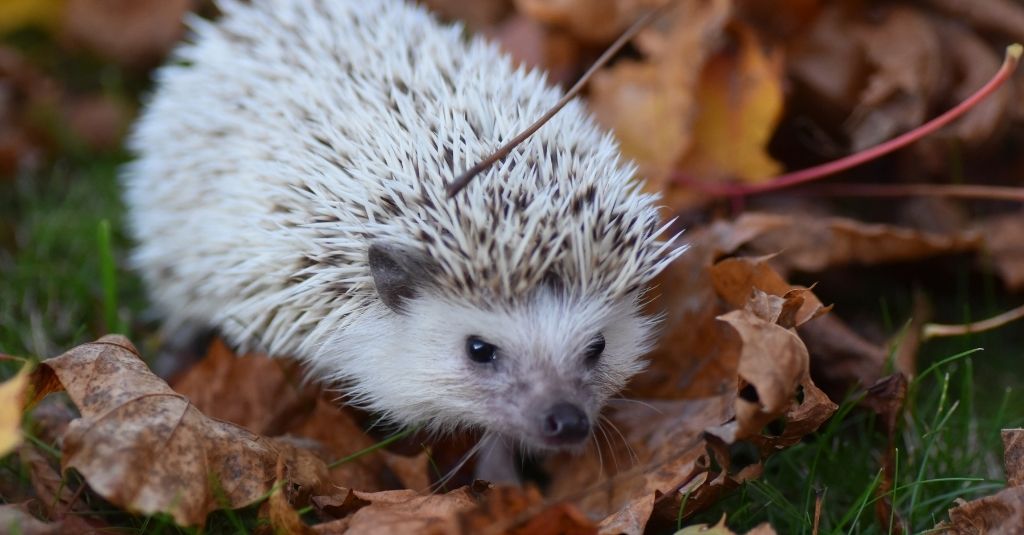
Hedgehogs are small nocturnal mammals that can be found anywhere in the world but are native to Africa, Europe, and Asia. They are omnivorous and feed on beetles, worms, and other insects in the wild. The African pygmy hedgehogs are more commonly kept as pets and are domesticated, so they are opportunistic omnivores, and would have a different diet than wild hedgehogs, like European hedgehogs and desert hedgehogs.
Hedgehogs curl into a ball as a defense mechanism.
Hedgehogs hide in the wild and are mostly kept indoors when domesticated, so many who aren’t familiar often mistake them for porcupines, which is a different species altogether. The main difference between hedgehogs and porcupines is the quills. Porcupines have 2-3 inches or foot-long quills, and they fall off easily. While hedgehogs have shorter quills that are about 1 inch long and do not lose their quills generally. Besides the noticeable difference in size and also animal family, they behave very differently. Hedgehogs curl into a ball as a defense mechanism. Meanwhile, porcupines’ quills will come off and prick onto their predators when it attacks.
Hedgehogs have an average life expectancy of 3 to 6 years. They come in around 90 different colors, the most common being salt and pepper, cinnamon, grey, brown, and chocolate.
Hedgehogs can be legally kept in many places around the world including all of Canada (with the exception of Windsor, Ontario and Langley, British Columbia), and most of the United States. Hedgehogs are illegal in Georgia, Hawaii, Pennsylvania, the 5 boroughs of New York City, and Douglas County in Nebraska. In the state of Maine, two permits are required to have a pet hedgehog.
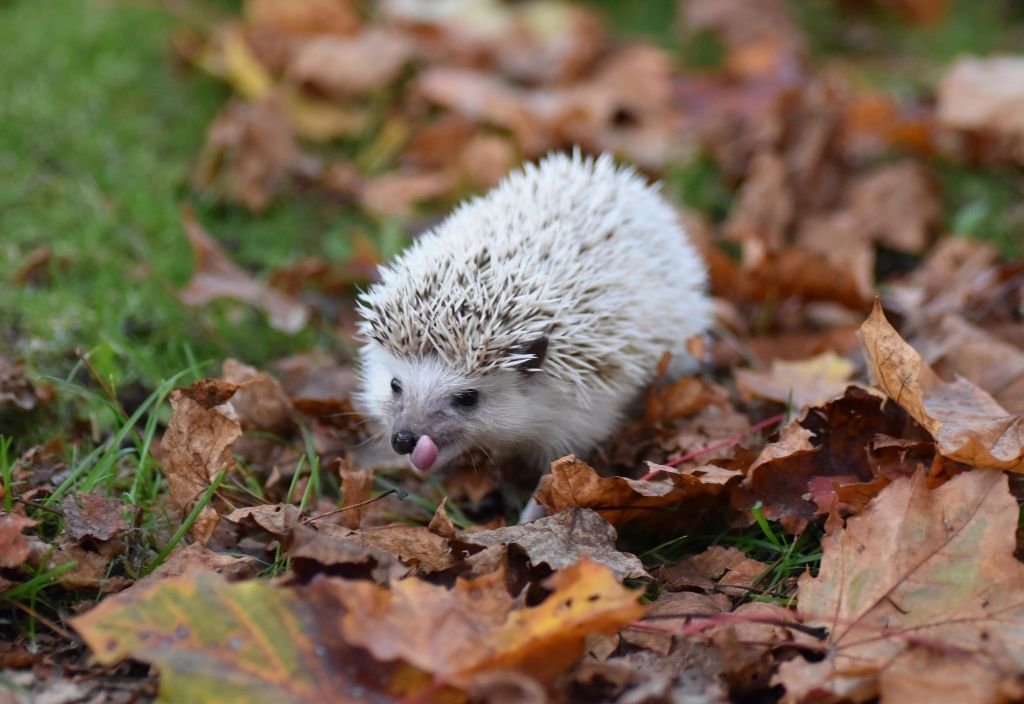
The diet for domesticated hedgies consists mainly of high-quality and grain-free cat food with protein like chicken, beef, pork, or even fish. Still, the latter should only be given in moderate amounts. Commercial hedgehog food is not suitable as there are many fillers in it, so many hedgehog breeders and parents prefer cat food. The ideal diet composition should be 30-33% protein and 10-12% of fat content. Sometimes you can also pair their main diet with unseasoned cooked meat, unseasoned boiled eggs, non-citrus fresh fruits like apple, banana, watermelon, and finely chopped and cooked vegetables. Since hedgies enjoy scavenging naturally, you may feed live insects like mealworms, super worms, crickets, dubia roaches, waxworms, but in moderation as the fat content can add up very quickly.
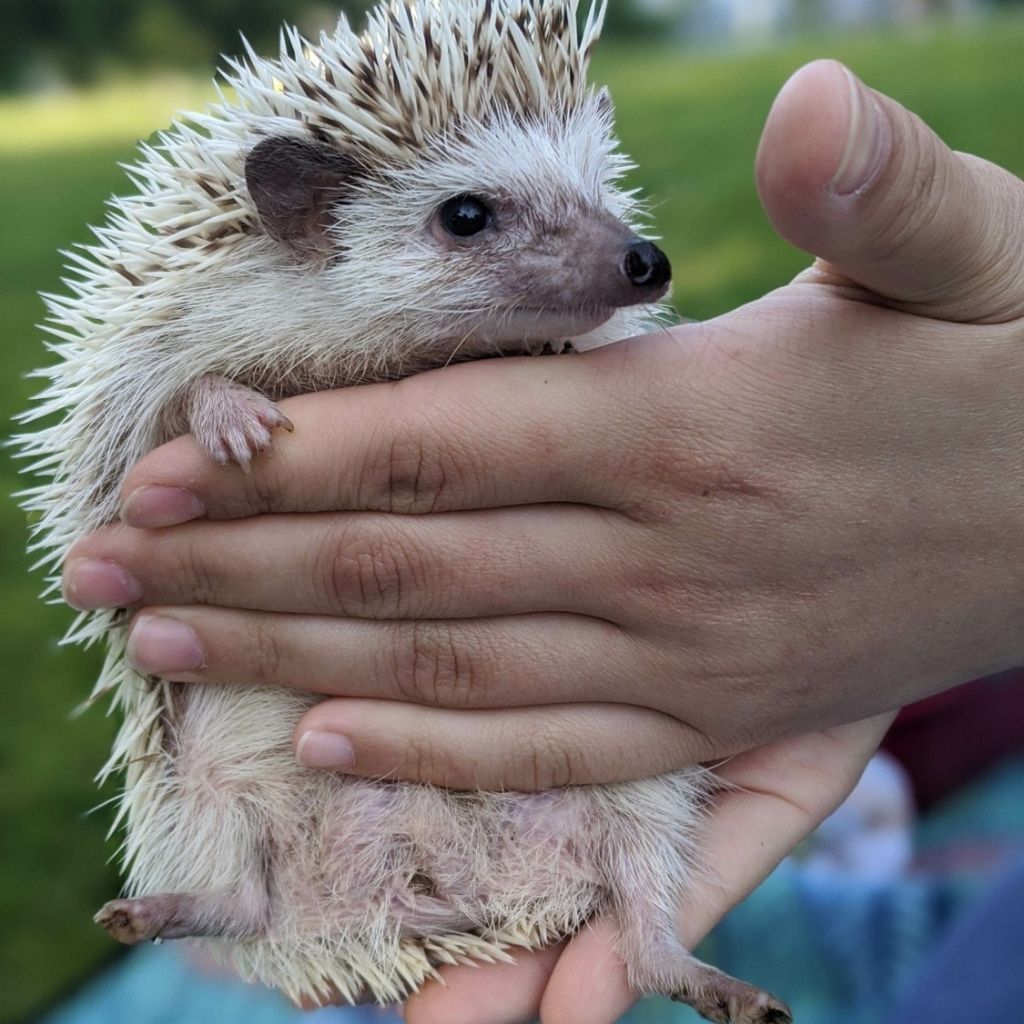
They are known to have soft and furry bellies and quills as hairs on their back. You’ll often see them curling up into a prickly ball whenever they are startled, afraid, or annoyed. Sometimes they do this with a hissing and popping sound to deter their predators, which may overwhelm new pet parents at times. This doesn’t necessarily mean your hedgehog doesn’t like you, it is a natural response, and it will take them a while to uncurl once they know they’re in a safe space.
Well-socialized hedgehogs usually relax and curl less, which is why it’s helpful to get your hedgies familiar with your scent! You can start to do so by placing old clothing or even socks in their house. Despite this, hedgehogs can interact well with humans, and it’s best to spend at least 15 minutes a day with them to create a bond. Evenings or nighttime would be the best as that is when they are usually awake. You may do so with the old t-shirt trick, a cuddle pouch, or with bare hands.
It can be stressful establishing a bond for a first-time owner, so it can be a good idea to take it slow and not be deterred by their prickliness. Some hedgies may also take your hesitation towards their grumpiness as a reward for leaving them alone, which will usually encourage their irritability. Usually, hedgehogs will relax once they see their humans in a more relaxed state too. Although gloves may seem like a good tool to handle a hedgehog, this is not recommended as your hedgie will not be as familiar with your scent and touch it this way. The best way to pick up a hedgehog is to call for them, wait for them to uncurl, and place two of your hands underneath their belly.

Before getting a hedgehog, you must know that they require at least 3 – 4 square feet, so they can have plenty of room to explore and hide. Most opt for the C&C setup, DIY cabinets, or even commercial small pet housing cages. One thing to be mindful of is to make sure to cover any grids with a smooth surface. This can help to prevent escape artists from climbing. Most hedgies enjoy hiding and sleeping, especially during the daylight, so it’s essential to set up sleeping areas for them with fleece bedding or cat litter to burrow in.
Having a constant heat source is exceptionally important since it can be very dangerous for a domesticated hedgehog to attempt hibernation, which can be deadly and a health hazard. If you find your prickly baby attempting hibernation, please keep them warm immediately with your body heat or a heat source. Please avoid placing them in warm water directly. The recommended temperature is between 72-80 degrees Fahrenheit or 22-26 degrees Celsius. Anything too hot may also cause health complications, like heat stroke or heat exhaustion. It’s best to get a thermostat so the heat source will be constant.
Heat pads or hand warmers with covers are suitable for traveling but not as a constant heat source. Make sure to never directly expose them to a heat source and have a covering in between to avoid heat burns. We recommend ceramic heat emitters (CHEs) as a steadier and more reliable heat supply. Unlike reptiles, hedgehogs do not need UV light. A constant light source, like a floor lamp or ceiling light, is adequate, as this way, they can tell the difference between daylight and nighttime. Hedgehogs sleep a lot and can sleep up to 18 hours, especially when they are younger. So don’t be surprised when your hedgehog is only active for a couple of hours before you sleep! They will very often be busy running on their wheels and snacking away during the night.
For bedding, fabric liners like fleece, flannel, or corduroy fabrics are the best choices for your baby, as they are soft, warm, and more resistant to digging (a natural habit of hedgehogs). Loose ends of fabric should be avoided as sometimes it can be a health hazard to their tiny feet. You may also use wood shavings like aspen or pine (NEVER cedar) or paper kitty litter. Still, it may cause allergies, dry skin, respiratory irritation, contain mites, or even getting caught in the penile, eyes, which may cause injuries and illness.
Hedgehogs are natural burrowers. They look for hiding places regularly, especially to sleep and seek shelter. You can find commercially available hiding places like igloos, hiding logs, or snuggle sacks are among the common ones. You can even provide extra bedding material inside the hiding places, so they feel even safer, and they can keep hidden and warm. Sometimes PVC pipes can be a cute and fun tunnel for them to hide as well. Just make sure to get one that can fit your hedgie comfortably.
The perfect food bowl is usually heavy ceramic, 3 to 6 inches wide and no more than 3 inches high. If the bowl is too light, the hedgehog can use it as a toy and dump the food all over. Although it might be fun (for them), it is not practical or clean.
Your hedgie’s water bowl may also be the same kind as their food bowl, or you can even use a waterer. Spring-loaded water bottles are not recommended as they may chip their tooth when they bite hard. Also, it is important to continually clean the bowls and provide fresh water to your quilled baby.
A wheel is essential as it can help keep your hedgehog entertained and active. It is part of their environment enrichment, so your prickly furriend can have a happy and healthy quality of life.
Hedgehogs can also be trained to use a litter box. It is best to place this under their running wheel. You may use reusable puppy pads, disposable puppy pads, paper towels, or kitty litter.
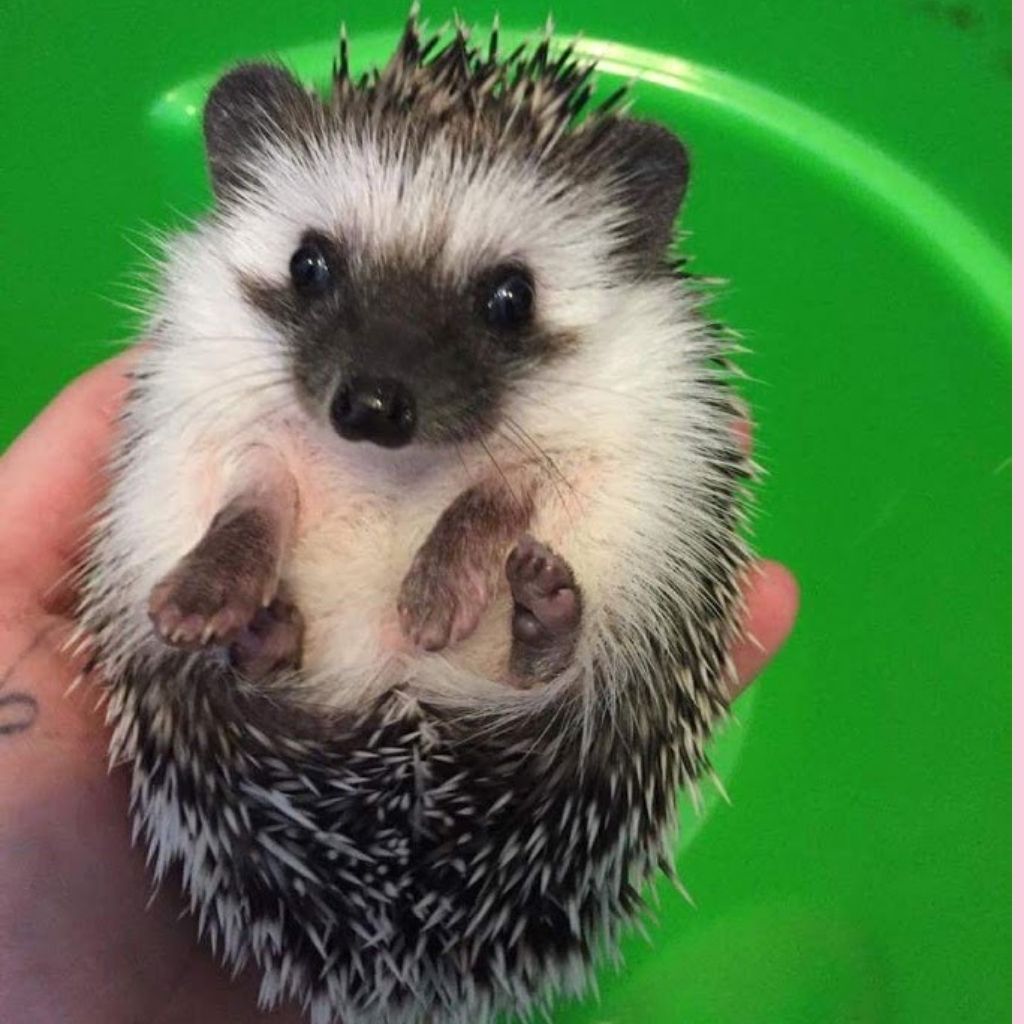
A healthy hedgehog shape is when they can curl up into a perfect ball and when they have tear-dropped shaped. If your hedgehog is overweight, it would be a good idea to speak to your vet to review their diet and come up with a treatment plan. This is where an exercise wheel comes into play. The best kind of wheel is flat and smooth surface ones, like a bucket wheel. Hamster wheels, discs, silent spinners, wooden wheels, and grid wheels may not be appropriate due to size and health hazards. Wheel covers are also unnecessary since they may lead to urine burn if not appropriately monitored. The best wheel size is 11-12 inches and a minimum of 4 inches wide, this way, it provides a stable runway for them!
Sandpaper is also unnecessary as the best way to trim our hedgies nails is with a small nail trimmer or animal-friendly nail trimmer. The best way to help uncurl them during the nail trimming process is to place them in shallow and warm water.
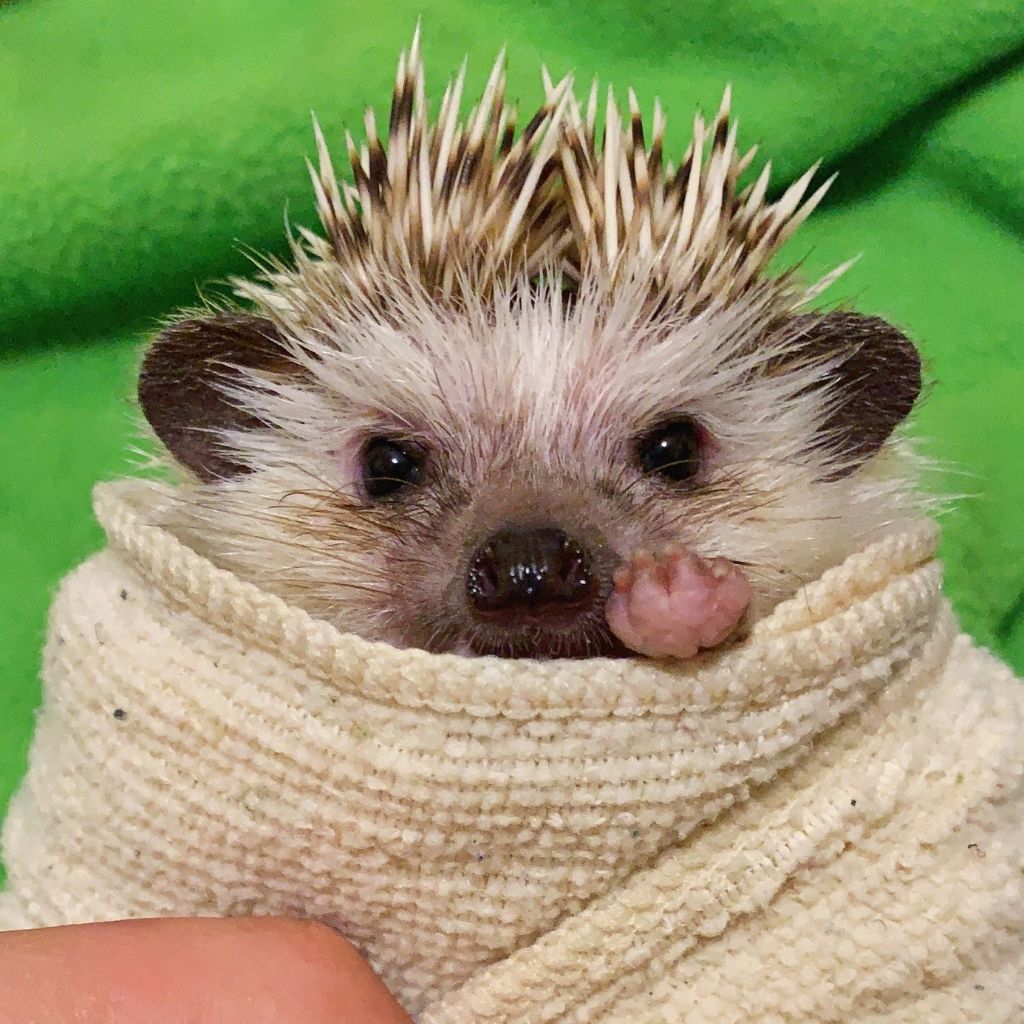
While choosing a good hedgehog as a companion, pay attention that they must be at least 8 weeks old, have bright and attentive eyes, clean ears and nose, intact quills on the back, no signs of fleas, mites, or diarrhea in the pen. It is important to also get your hedgehog from an ethical breeder as backyard breeding often leads to hedgehogs with poor genetics, like wobbly hedgehog syndrome (WHS). In some areas, you may also be able to find rescued hedgehogs in need of a loving home. If ever in doubt, if the hedgehog is healthy or not, consult a trusted veterinarian.
Patience is key when you bring a new baby hoglet home. It is usual for them to be startled and defensive as they will need some time to adjust to the new place and your scent. Ideally, they will probably need around a week before feeling comfortable at the new home and a little bit more time before developing a relationship with you.
Just like many species of furry friends, NHV has some options for supplements that can help hedgehogs have a healthy life.
Turmeric extract has anti-inflammatory and nutritive properties that promote overall vitality while helping to support a variety of health conditions such as cancer, heart conditions, and arthritis. It also has a high concentration of antioxidants and is excellent anti-inflammatory support. Studies have found the antioxidant effect of turmeric appears to be so powerful that it may stop the kidney from being damaged by toxins. Studies have also linked the frequent use of turmeric to lower rates of certain types of cancers as well. In hedgehogs, it can help with eye health since eye problems like prolapsed eyes and cataracts are a concern within the species. This herb is found in many hedgehog foods, but if your little one needs extra support, NHV can help you and your baby.
Yucca contains two very beneficial compounds: Sarsasapegenin and smilagenin. These two compounds work on the mucous membranes of the small intestine helping with the absorption of minerals and vitamins. Sarsasapogenin and Smilagenin are also known as steroidal saponins which act as precursors to corticoids helping with symptom relief related to inflammation, discomfort, and loss of appetite. Our Yucca is formulated and dosed specifically to be safe for long-term use in pets. In hedgehogs, it seems to help with appetite, in case your little one is having a poor appetite.
Milk Thistle (Silybum ebumeum or Silybum marianum) has been used for over 2000 years as a remedy for various types of liver diseases. In fact, studies have shown that Milk Thistle can decrease or reverse damage to the liver and kidneys. It can help detoxify the liver and kidneys by removing toxins that can build up in a pet’s system when taking pharmaceuticals or chemical-laden foods. Milk Thistle also has antioxidant properties and may benefit as anti-cancer support.
Tripsy is a soothing formula that helps control infection, has a demulcent effect on urinary calculi, and supports the health of the kidneys and bladder. Hedgehogs are particularly prone to UTIs since it is easy for grains and dirt to get stuck in the penile. Tripsy may help in case your hedgehog is facing any kidney, urinary, or bladder problems.
discomfort support


Support for Discomfort and Appetite Stimulant
buy 2 and save $3
3 month supply for a small to medium size
NHV Yucca is used for cats as a supplement to provide nutrients, and may be helpful for discomfort, inflammation, and to increase or balance the appetite.


NHV Yucca is used for cats as a supplement to provide nutrients, and may be helpful for discomfort, inflammation, and to increase or balance the appetite.

Yucca is used in cat food as well as food for other animals around the world. Its root is a highly nutritious herb that’s rich in vitamin C, beta-carotene, B vitamins, magnesium, iron, calcium, manganese, protein, niacin, and phosphorus.
Yucca contains two very beneficial compounds: sarsasapogenin and smilagenin. These two compounds work on the mucous membranes of the small intestine. These compounds help with the penetration and absorption of minerals and vitamins. Sarsasapogenin and smilagenin are known as steroidal saponins (phytosterols) which act as precursors to corticosteroids produced naturally by the body.
Steroidal saponins support the immune function of the body while stimulating and supporting the production of its own corticosteroids and corticosteroid–related hormones. Due to this action, studies conducted on Yucca have shown that it may be beneficial and effective for discomfort relief and inflammation in conditions such as arthritis. Yucca for cats may also be a natural appetite stimulant and may also help reduce the production of urease, which contributes to the unpleasant odors of urine and feces in some cats.

Yucca - Commonly used for supporting arthritis, as an anti-inflammatory, nutritive, antitumor, and digestive supplement.
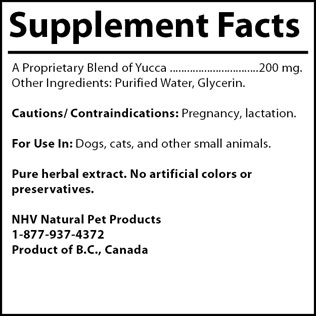
Select your pet's weight to determine the correct dose.
To be taken twice daily. Determine your pet’s weight and then use the easy chart below to determine the correct dose. This is the minimum dosage.
Pet's Weight Dosage
0 - 15 lb = 0.5 ml
16 - 30 lb = 1.0 ml
31 - 45 lb = 1.5 ml
46 - 60 lb = 2.0 ml
61 - 75 lb = 2.5 ml
Over 75 lb = 3.0 ml
How to Administer: Shake well before use. The easiest method is to use the dropper provided and place the drops into your pet’s food or favorite treat. You can also use the dropper and squirt directly into the pet’s mouth. Some pets can be finicky, if this occurs consider hiding the drops in foods most pet’s love such as fish, chicken, yogurt, or a favorite treat. If your pet only eats dry food then soak a few kibbles at feeding time.
For Best Results: Herbal dietary supplements are beneficial to the health and well-being of your pet and are safe for long-term use. Every pet responds to natural herbal supplements differently, therefore it is important to be consistent and administer the product daily. Supplements generally take two to four weeks to take effect, however this will vary from one animal to the next.
Product Storage:
All NHV Natural Pet Products are pure herbal extracts and contain no artificial additives, preservatives or coloring. Shelf life after opening is 6 months and must be refrigerated after opening.
Cautions and Contraindications
Do not use Yucca in pregnant or nursing animals.
Speak to your vet before using our products. A second visit is recommended if your pet’s condition does not improve, or deteriorates after continued use of the supplements. All information provided by NHV Natural Pet Products is for educational purposes only.
Yucca is used in cat food as well as food for other animals around the world. Its root is a highly nutritious herb that’s rich in vitamin C, beta-carotene, B vitamins, magnesium, iron, calcium, manganese, protein, niacin, and phosphorus.
Yucca contains two very beneficial compounds: sarsasapogenin and smilagenin. These two compounds work on the mucous membranes of the small intestine. These compounds help with the penetration and absorption of minerals and vitamins. Sarsasapogenin and smilagenin are known as steroidal saponins (phytosterols) which act as precursors to corticosteroids produced naturally by the body.
Steroidal saponins support the immune function of the body while stimulating and supporting the production of its own corticosteroids and corticosteroid–related hormones. Due to this action, studies conducted on Yucca have shown that it may be beneficial and effective for discomfort relief and inflammation in conditions such as arthritis. Yucca for cats may also be a natural appetite stimulant and may also help reduce the production of urease, which contributes to the unpleasant odors of urine and feces in some cats.

Yucca - Commonly used for supporting arthritis, as an anti-inflammatory, nutritive, antitumor, and digestive supplement.

Select your pet's weight to determine the correct dose.
To be taken twice daily. Determine your pet’s weight and then use the easy chart below to determine the correct dose. This is the minimum dosage.
Pet's Weight Dosage
0 - 15 lb = 0.5 ml
16 - 30 lb = 1.0 ml
31 - 45 lb = 1.5 ml
46 - 60 lb = 2.0 ml
61 - 75 lb = 2.5 ml
Over 75 lb = 3.0 ml
How to Administer: Shake well before use. The easiest method is to use the dropper provided and place the drops into your pet’s food or favorite treat. You can also use the dropper and squirt directly into the pet’s mouth. Some pets can be finicky, if this occurs consider hiding the drops in foods most pet’s love such as fish, chicken, yogurt, or a favorite treat. If your pet only eats dry food then soak a few kibbles at feeding time.
For Best Results: Herbal dietary supplements are beneficial to the health and well-being of your pet and are safe for long-term use. Every pet responds to natural herbal supplements differently, therefore it is important to be consistent and administer the product daily. Supplements generally take two to four weeks to take effect, however this will vary from one animal to the next.
Product Storage:
All NHV Natural Pet Products are pure herbal extracts and contain no artificial additives, preservatives or coloring. Shelf life after opening is 6 months and must be refrigerated after opening.
Cautions and Contraindications
Do not use Yucca in pregnant or nursing animals.
Speak to your vet before using our products. A second visit is recommended if your pet’s condition does not improve, or deteriorates after continued use of the supplements. All information provided by NHV Natural Pet Products is for educational purposes only.
liver support
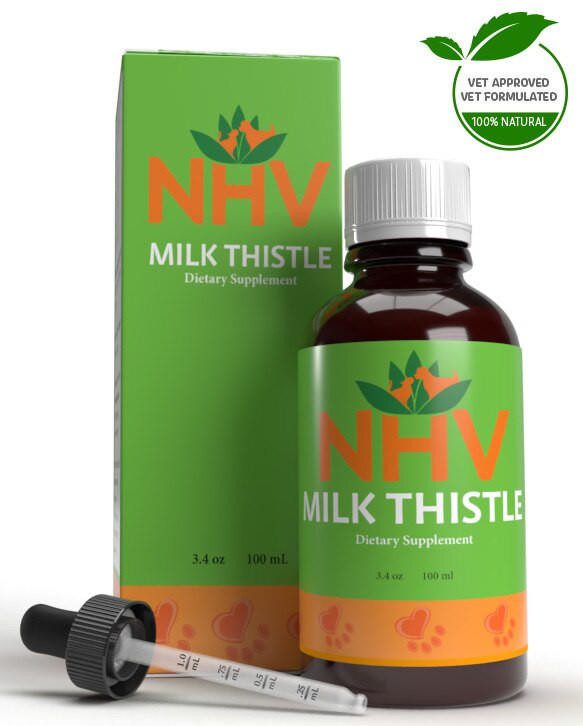
Natural Liver support for hamsters, guinea pigs & other small pets
buy 2 and save $3
3 month supply for a small to medium size pet
The liver filters anything that your hamster, bunny or hedgehog may eat. If your pet gets sick, their liver may be underfunctioning and have a tough time eliminating toxins. NHV Milk Thistle is a natural liver support that may help the body remove metabolic wastes, may help to improve liver function and may help support the kidneys as well.


The liver filters anything that your hamster, bunny or hedgehog may eat. If your pet gets sick, their liver may be underfunctioning and have a tough time eliminating toxins. NHV Milk Thistle is a natural liver support that may help the body remove metabolic wastes, may help to improve liver function and may help support the kidneys as well.

The liver is an organ with many important functions. Its many responsibilities include filtering toxins out of the blood, releasing bile for effective digestion and more. Because the liver is so vital to the health of all pocket pets, Milk Thistle is especially beneficial for pets fighting off serious illnesses like cancer or fatty liver disease. It contains the active compound silymarin, which may help to detoxify the liver and encourages cell regeneration. Studies have shown that Milk Thistle may also help support kidney function.
Tumors are fairly common for many pocket pets, like cases of hamster liver cancer or guinea pig liver failure. Milk Thistle contains the active compound silymarin which has been used for thousands of years for its many beneficial properties. If your pet gets cancer, they will most likely be prescribed powerful cancer medications which can damage the kidneys and damage the liver. So in terms of cancer support, milk thistle is extremely beneficial to help offset the negative effects of medications and support liver function due to its rich concentration of free radical scavengers.
It’s great to know that there are ways to support your little one’s health naturally! All NHV products use only the finest organic, wild-crafted ingredients and formulated by the combined efforts of a master herbalist and veterinarian with 50+ years of experience. If you have any questions about natural liver support or need any holistic advice, please get in touch with an NHV Pet Expert - we are always happy to help!
Made with the finest, organically grown, or ethically harvested herbs. Made specifically for pets, vet-formulated and vet approved.
Select your pet's weight to determine the correct dose.
For ferrets: 0.5ml twice a day
For rabbits and guinea pigs: 0.5 ml twice a day
For hamsters and mice: 1 drop per two pounds twice a day
How to Administer
Shake well before use. The easiest method is to use the dropper provide and places the drops into your pet’s food or favorite treat. You can also use the dropper and squirt directly into the pet’s mouth.
Some pets can be finicky, if this occurs consider hiding the drops in foods most pet’s love such as mashed banana, strawberry or another favorite treat.
For Best Results
Herbal dietary supplements are beneficial to the health and wellbeing of your pet and are safe for long-term use. Every pet responds to natural herbal supplements differently, therefore it is important to be consistent and administer the product daily. Supplements generally take two to four weeks to take effect, however this will vary from one animal to the next.
Product Storage
All NHV Natural Pet Products are pure herbal extracts and contain no artificial additives, preservatives or coloring. Shelf life after opening is 6 months and must be refrigerated after opening.
Cautions and Contraindications
Do not use Milk Thistle in pregnant or nursing animals. Speak to your vet before using our products. A second visit is recommended if your pet’s condition does not improve, or deteriorates after continued use of the supplements.
All information provided by NHV Natural Pet Products is for educational purposes only.
The liver is an organ with many important functions. Its many responsibilities include filtering toxins out of the blood, releasing bile for effective digestion and more. Because the liver is so vital to the health of all pocket pets, Milk Thistle is especially beneficial for pets fighting off serious illnesses like cancer or fatty liver disease. It contains the active compound silymarin, which may help to detoxify the liver and encourages cell regeneration. Studies have shown that Milk Thistle may also help support kidney function.
Tumors are fairly common for many pocket pets, like cases of hamster liver cancer or guinea pig liver failure. Milk Thistle contains the active compound silymarin which has been used for thousands of years for its many beneficial properties. If your pet gets cancer, they will most likely be prescribed powerful cancer medications which can damage the kidneys and damage the liver. So in terms of cancer support, milk thistle is extremely beneficial to help offset the negative effects of medications and support liver function due to its rich concentration of free radical scavengers.
It’s great to know that there are ways to support your little one’s health naturally! All NHV products use only the finest organic, wild-crafted ingredients and formulated by the combined efforts of a master herbalist and veterinarian with 50+ years of experience. If you have any questions about natural liver support or need any holistic advice, please get in touch with an NHV Pet Expert - we are always happy to help!
Made with the finest, organically grown, or ethically harvested herbs. Made specifically for pets, vet-formulated and vet approved.
Select your pet's weight to determine the correct dose.
For ferrets: 0.5ml twice a day
For rabbits and guinea pigs: 0.5 ml twice a day
For hamsters and mice: 1 drop per two pounds twice a day
How to Administer
Shake well before use. The easiest method is to use the dropper provide and places the drops into your pet’s food or favorite treat. You can also use the dropper and squirt directly into the pet’s mouth.
Some pets can be finicky, if this occurs consider hiding the drops in foods most pet’s love such as mashed banana, strawberry or another favorite treat.
For Best Results
Herbal dietary supplements are beneficial to the health and wellbeing of your pet and are safe for long-term use. Every pet responds to natural herbal supplements differently, therefore it is important to be consistent and administer the product daily. Supplements generally take two to four weeks to take effect, however this will vary from one animal to the next.
Product Storage
All NHV Natural Pet Products are pure herbal extracts and contain no artificial additives, preservatives or coloring. Shelf life after opening is 6 months and must be refrigerated after opening.
Cautions and Contraindications
Do not use Milk Thistle in pregnant or nursing animals. Speak to your vet before using our products. A second visit is recommended if your pet’s condition does not improve, or deteriorates after continued use of the supplements.
All information provided by NHV Natural Pet Products is for educational purposes only.
kidney & bladder support
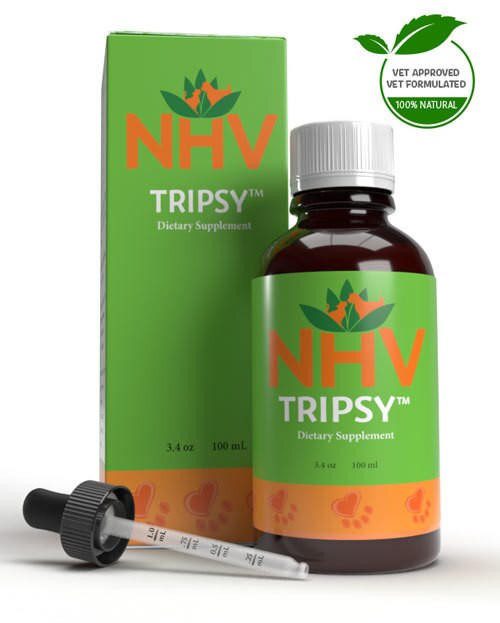
Holistic Rabbit Kidney Supplement
buy 2 and save $3
3-6 Month supply
Just like humans, pet rabbits can develop kidney problems. Some common symptoms of rabbit kidney problems are straining to urinate, more frequent urination, and inappropriate urination. NHV Tripsy™ is an all-natural plant-based rabbit kidney supplement that helps support the kidneys and bladder to encourage healthy urinary and kidney health.

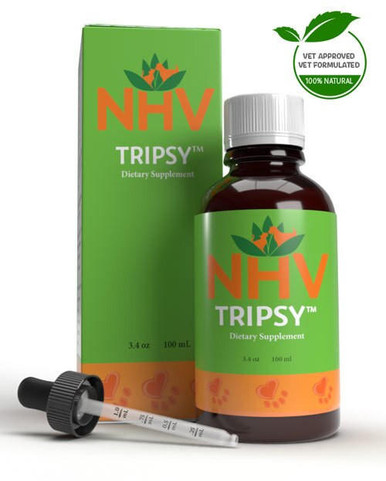
Just like humans, pet rabbits can develop kidney problems. Some common symptoms of rabbit kidney problems are straining to urinate, more frequent urination, and inappropriate urination. NHV Tripsy™ is an all-natural plant-based rabbit kidney supplement that helps support the kidneys and bladder to encourage healthy urinary and kidney health.

Holistic Rabbit Kidney Supplement Support
Sometimes it can be tricky to tell what is bothering your furry companion, because no two pets are alike! But a common health issue that affects our bunny pals is kidney disease. These two bean-shaped organs have several key roles: removing metabolic wastes from the body and maintaining the correct balance of water and electrolytes (salts) within the body. Another important role is producing essential hormones that help maintain healthy blood pressure, production of new blood cells, and allow the body to absorb salt. Lastly, the urinary system processes vitamin D - an integral component for calcium absorption and bone growth.
The two most common types of renal issues are kidney degeneration (often age-related) which can lead to organ failure and acute kidney failure, where symptoms develop suddenly over a few days or weeks and can lead to the kidneys shutting down quickly. This may cause irregularities in your bunny’s urinary output. To figure out if your furkiddo has kidney issues, your vet can run some tests like bloodwork, urinalysis, radiographs, ultrasounds, and/or CT scans, to further investigate their symptoms. The typical course of action for rabbit kidney problems includes intravenous fluid therapy (under the supervision of your trusted vet), the addition of glycoproteins and a kidney-specific, balanced diet.
Symptoms of Rabbit Kidney Problems
For kidney degeneration or acute kidney issues, we'd suggest adding a natural rabbit kidney supplement like NHV Tripsy™ to your bunny's daily feeding schedule. It can safely be used short-term as well as long-term as a natural health support. Tripsy™ promotes healthy kidney, bladder, and urinary tract functions and may eliminate kidney stone formation in all of your bunny pals (both young and old).
How NHV’s Supplements Ease Rabbit Kidney Problems
Kidney issues can cause a lot of stress and worry in your Lop and Lionhead pals. Ingredients like parsley piert and stone root have diuretic properties that gently regulate urine flow, if on the low/infrequent side, to help keep things flowing normally and prevent the formation of kidney and bladder calculi (often called stones). Herbs like Wild hydrangea and Gravel root have traditionally been used for supporting kidney and urinary health by helping to break down, dissolve and remove stones and prevent urinary tract infections (UTIs). Other ingredients like Echinacea purpurea and Oregon grape's defense against microorganisms help combat infections. And lastly, Marshmallow soothes irritated internal tissues and protects cells from oxidative damage.
Causes for Kidney Issues in Rabbits
Help your Rabbit Bounce Back from Rabbit Kidney Problems Naturally
Part of being a pet parent is doing everything you can to support your furkiddo. NHV Natural Pet Products are plant-based and their liquid formulations make them easy to hide in food so getting them to take their daily dose is a total breeze. If you ever feel like you need an extra hand (or paw) when it comes to kidney problems in rabbits, our team of vets and pet experts is always here to help you. Click the button below to get started!
Made with the finest, organically grown, or ethically harvested herbs. Made specifically for pets, vet-formulated and vet approved.
Tripsy™ for Rabbit Kidney Support
For Rabbits: 0.5ml twice daily
How to Administer
Shake well before use. The easiest method is to use the dropper provide and places the drops into your pet’s food or favorite treat. You can also use the dropper and squirt directly into the pet’s mouth.
Some pets can be finicky, if this occurs consider hiding the drops in foods most pet’s love such as mashed banana, strawberry or another favorite treat.
For Best Results
Herbal dietary supplements are beneficial to the health and wellbeing of your pet and are safe for long-term use. Every pet responds to natural herbal supplements differently, therefore it is important to be consistent and administer the product daily. Supplements generally take two to four weeks to take effect, however this will vary from one animal to the next.
Product Storage
All NHV Natural Pet Products are pure herbal extracts and contain no artificial additives, preservatives or coloring. Shelf life after opening is 6 months and must be refrigerated after opening.
Cautions and Contraindications
Do not use Tripsy if your pet is pregnant. No known side effects. Speak to your vet before using our products. A second visit is recommended if your pet’s condition does not improve, or deteriorates after continued use of the supplements.
All information provided by NHV Natural Pet Products is for educational purposes only.
Holistic Rabbit Kidney Supplement Support
Sometimes it can be tricky to tell what is bothering your furry companion, because no two pets are alike! But a common health issue that affects our bunny pals is kidney disease. These two bean-shaped organs have several key roles: removing metabolic wastes from the body and maintaining the correct balance of water and electrolytes (salts) within the body. Another important role is producing essential hormones that help maintain healthy blood pressure, production of new blood cells, and allow the body to absorb salt. Lastly, the urinary system processes vitamin D - an integral component for calcium absorption and bone growth.
The two most common types of renal issues are kidney degeneration (often age-related) which can lead to organ failure and acute kidney failure, where symptoms develop suddenly over a few days or weeks and can lead to the kidneys shutting down quickly. This may cause irregularities in your bunny’s urinary output. To figure out if your furkiddo has kidney issues, your vet can run some tests like bloodwork, urinalysis, radiographs, ultrasounds, and/or CT scans, to further investigate their symptoms. The typical course of action for rabbit kidney problems includes intravenous fluid therapy (under the supervision of your trusted vet), the addition of glycoproteins and a kidney-specific, balanced diet.
Symptoms of Rabbit Kidney Problems
For kidney degeneration or acute kidney issues, we'd suggest adding a natural rabbit kidney supplement like NHV Tripsy™ to your bunny's daily feeding schedule. It can safely be used short-term as well as long-term as a natural health support. Tripsy™ promotes healthy kidney, bladder, and urinary tract functions and may eliminate kidney stone formation in all of your bunny pals (both young and old).
How NHV’s Supplements Ease Rabbit Kidney Problems
Kidney issues can cause a lot of stress and worry in your Lop and Lionhead pals. Ingredients like parsley piert and stone root have diuretic properties that gently regulate urine flow, if on the low/infrequent side, to help keep things flowing normally and prevent the formation of kidney and bladder calculi (often called stones). Herbs like Wild hydrangea and Gravel root have traditionally been used for supporting kidney and urinary health by helping to break down, dissolve and remove stones and prevent urinary tract infections (UTIs). Other ingredients like Echinacea purpurea and Oregon grape's defense against microorganisms help combat infections. And lastly, Marshmallow soothes irritated internal tissues and protects cells from oxidative damage.
Causes for Kidney Issues in Rabbits
Help your Rabbit Bounce Back from Rabbit Kidney Problems Naturally
Part of being a pet parent is doing everything you can to support your furkiddo. NHV Natural Pet Products are plant-based and their liquid formulations make them easy to hide in food so getting them to take their daily dose is a total breeze. If you ever feel like you need an extra hand (or paw) when it comes to kidney problems in rabbits, our team of vets and pet experts is always here to help you. Click the button below to get started!
Made with the finest, organically grown, or ethically harvested herbs. Made specifically for pets, vet-formulated and vet approved.
Tripsy™ for Rabbit Kidney Support
For Rabbits: 0.5ml twice daily
How to Administer
Shake well before use. The easiest method is to use the dropper provide and places the drops into your pet’s food or favorite treat. You can also use the dropper and squirt directly into the pet’s mouth.
Some pets can be finicky, if this occurs consider hiding the drops in foods most pet’s love such as mashed banana, strawberry or another favorite treat.
For Best Results
Herbal dietary supplements are beneficial to the health and wellbeing of your pet and are safe for long-term use. Every pet responds to natural herbal supplements differently, therefore it is important to be consistent and administer the product daily. Supplements generally take two to four weeks to take effect, however this will vary from one animal to the next.
Product Storage
All NHV Natural Pet Products are pure herbal extracts and contain no artificial additives, preservatives or coloring. Shelf life after opening is 6 months and must be refrigerated after opening.
Cautions and Contraindications
Do not use Tripsy if your pet is pregnant. No known side effects. Speak to your vet before using our products. A second visit is recommended if your pet’s condition does not improve, or deteriorates after continued use of the supplements.
All information provided by NHV Natural Pet Products is for educational purposes only.
Published: February 24, 2021